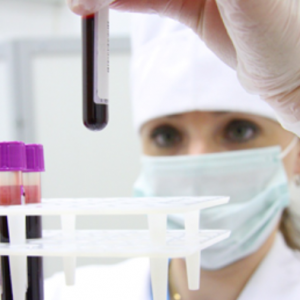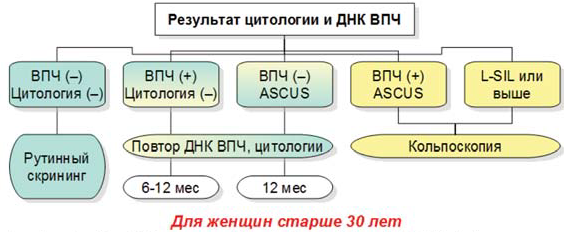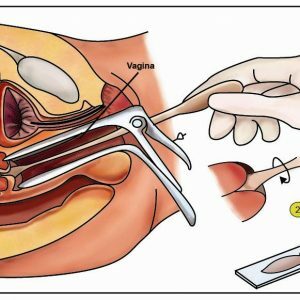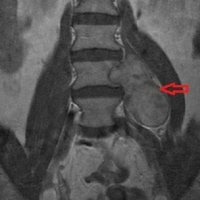Types of human papillomavirus( HPV) and methods for its diagnosis
 Human papillomavirus( HPV) is an infectious disease that is transmitted from person to person through direct contact( with unprotected sex acts, the child from the mother during childbirth).The localization of the virus can be on the skin or mucous membranes, this disease has different types and manifestations, but in any case should be subjected to professional treatment.
Human papillomavirus( HPV) is an infectious disease that is transmitted from person to person through direct contact( with unprotected sex acts, the child from the mother during childbirth).The localization of the virus can be on the skin or mucous membranes, this disease has different types and manifestations, but in any case should be subjected to professional treatment.
There are several methods for diagnosing human papillomavirus - they are all equally used in medicine, but differ in their characteristics, the principle of "work" and the level of accuracy of the results.Prevent infection with the disease allows the vaccine against HPV.
Table of contents: Types of human papilloma virus Methods for diagnosing HPV Recommended reading:Types of human papillomavirus
Recommended to read:Medicine knows 100 types of human papillomavirus. They are divided into two large groups:
- Oncogenic HPV types - this includes only 15 identified HPV types: 16, 18, 31, 33, 35, 39, 45, 51, 52, 56, 58, 59, 68,73, 82. These viruses may well provoke the appearance and growth of cancer cells.For example, if a woman was diagnosed with type 16 HPV, the probability of the degeneration of pathologically altered cells of the cervical mucosa into cancer is close to 90%. Important : infection with oncogenic types of human papillomavirus does not at all mean that the development of a malignant neoplasm is unavoidable.This is a high level of probability
- Benign( non-onocogenic) types of HPV are all the rest of the hundreds known.They can provoke the growth of genital warts, warts and even contribute to precancerous changes in the cervical tissues, but never cause malignant tumors.
Classification of types of human papilloma virus is presented in Table:
| Clinical manifestations | HPV types( oncogenic and benign) |
| Plantar warts are common warts Flat warts epidermodysplasia verruciformis Neborodavchatye skin lesions Condylomata( including, And pointed) Noncondylomatous lesions Carcinoma Laryngeal papilloma Carcinoma of the neck, the tongue | 1, 2, 4 2, 4, 26, 27, 29, 57 3, 10, 28, 49 5, 8, 9, 10, 12, 15,19, 36 37, 38 6, 11, 42, 43, 44, 54 43, 51, 52, 55,56, 57, 58, 59, 61, 64, 67, 68, 69, 70 16, 18, 31, 33, 35, 39, 45, 51, 52, 54, 56, 66, 68 6, 11. 30 2, 6, 11, 16, 18, 30 |
Please note: human papillomavirus virus 16 and 18 types are unconditionally oncogenic.
Methods for diagnosing HPV
To diagnose human papillomavirus, doctors can use several methods.In the first place for popularity and informativeness is PCR( polymer chain reaction), Digene-Test is second in terms of these characteristics, and a pap test( cytological study of tissues infected with human papillomavirus) is much less frequently used.
PCR in the diagnosis of HPV
Polymer chain reaction( PCR) is a method of laboratory diagnostics that allows isolating pathogens of infectious diseases, including human papillomavirus.
The principle of the method is to isolate human DNA as a "hostile" DNA.The fact is that any DNA consists of a combination of four nucleotides - adenine( A), thymidine( T), guanine( D), cytosine( C).They can be combined only in a certain order: A + T, G + C and nikaki otherwise - this is the basic rule of genetics.Every living organism has its own specific DNA and it can be isolated even with a microparticle at its disposal.It is on this that the principle of the method for diagnosing human papillomovirus in a polymer chain reaction is constructed: there is a specific HPV detector( as for other infectious diseases), the so-called DNA standard of the HPV activator.It is "run" into the DNA of the person being examined, and then the recognition of similar fragments, their combination and rapid division occurs-this is what the presence of the virus in the patient's blood will indicate. One cycle of the polymer chain reaction lasts no more than 180 seconds, a huge number of fragments of the virus DNA are formed per day - the duration of the diagnosis of the human papilloma virus by this method is one day.
One cycle of the polymer chain reaction lasts no more than 180 seconds, a huge number of fragments of the virus DNA are formed per day - the duration of the diagnosis of the human papilloma virus by this method is one day.
Advantages of PCR in the diagnosis of HPV
Theoretically, everything is clear - took the alleged patient's blood, injected into it a fragment of the DNA of the human papilloma virus and you can forget about the sample for a day.A day later we look through the microscope and find hundreds of thousands of fragments of this virus instead of one - you can make a diagnosis. In fact, the following advantages of this method of HPV diagnostics can be distinguished:
- Universality.When conducting diagnostic activities in relation to the human papillomavirus, other pathogens can be detected in parallel.In general, the PCR method is suitable for identifying many pathogens of infectious diseases - this is convenient for conducting a comprehensive survey.
- Specificity.The point is that with 100% guarantee in the diagnosis by the method of polymer chain reaction, the necessary causative agent stands out - there simply can not be mistakes.
- High sensitivity.At "start" of the standard of the concrete originator there is an opportunity to define only it or him - any other DNA of viruses will not create a hindrance for exact diagnostics.
- The speed with which results are obtained.Since the period of one polymer chain reaction is 3 minutes, the results of the examination can be obtained after a day - this time is quite enough to detect a large number of fragments of the DNA of the human papillomavirus.
The polymer chain reaction determines the specific pathogen, not the symptoms / signs of the disease.This allows you to diagnose a human papillomavirus in the incubation period, when there are no manifestations of this disease yet.
Disadvantages of PCR
Despite the many advantages of HPV diagnosis by the polymer chain reaction method, there are some drawbacks of this procedure:
- firstly, the human factor.At the disposal of laboratory workers there should be the most modern technology - for example, only the biological filter for the study should have an efficiency of at least 99.9%.It is used to purify air in a laboratory room - it can contain hundreds of thousands of viruses and bacteria that will "drop" their DNA fragments into the material under investigation - this leads to false results.
- second, to decipher the results of the diagnosis of HPV by the method of polymer chain reaction should only the attending physician of the patient being examined.The fact is that not always a positive result of diagnosis means HPV disease - for example, if a patient has recently been treated for some kind of disease and all the indicators "talk" about complete health, then DNA may contain decomposing fragments of HPV DNA;
- third, the doctor who takes the materials for the study must have a certain qualification.Very often the patient with obvious clinical signs of the developing human papillomavirus, the result of PCR analyzes is negative - this means that the material was removed from the laboratory to deal with it.
Digene-Test for the diagnosis of HPV in women
This method of diagnosing the human papillomavirus is more sensitive and informative than PCR. It allows not only to reveal the fact of presence of the HPV pathogen, but also to give him the characteristic:
- whether it is oncogenic or refers to benign;
- its concentration in tissues, which can be of clinical significance.
The test is performed as follows.From the cervix, vaginal discharge is removed, after which a small brush is inserted inside and scrolled around its axis 3 times in the cervical canal.Then the brush is removed from the cervix and placed in a special test tube with medium.In the laboratory, the material is tested for oncogenic HPV types.Digene-Test is so reliable that it is often used as a screening - especially it is important when the human papilloma virus affects the cervix.It is the method of diagnostics that can be used to accurately establish the level of risk of the degeneration of pathologically altered tissue cells into cancerous ones. Oncogenic types of HPV differ in ability to stay in a "frozen" state for a long time, which makes the diagnosis of a "precancerous condition" possible.
Digene-Test is recommended for women over 30 years of age - this category of gynecological clinic patients is at risk of developing cervical cancer against the background of HPV oncogenic type. If the diagnosis by the method under consideration gave a positive result in the study of women under 30 years, then it is recommended to conduct a second screening in not less than 9 months.
In the case of the Digene Test, women older than 30 years should adhere to the following principles:
- If there is a clinical picture of the development of HPV( the gynecologist performed colposcopy and cytoscopy), the doctor should make predictions about the level of probability of rapid development of cervical cancer;
- in case of receiving a negative result of Digene-Test it is recommended to conduct a second examination after a year and a half.
PAD testing for women
 This is the oldest method of diagnosing human papillomavirus, it is used only when examining women and allows you to see only changes in the human papillomavirus cells of the cervix.The essence of the method: the doctor makes scraping from the cervix and sends the material to a laboratory study.There, the material smeared on the glass is stained and the cytologist under the microscope differentiates the healthy and diseased cells.
This is the oldest method of diagnosing human papillomavirus, it is used only when examining women and allows you to see only changes in the human papillomavirus cells of the cervix.The essence of the method: the doctor makes scraping from the cervix and sends the material to a laboratory study.There, the material smeared on the glass is stained and the cytologist under the microscope differentiates the healthy and diseased cells.
If a positive result occurs, that is, pathologically altered cells are present, it is recommended that a woman undergo a more thorough / in-depth examination - it is not necessarily the human papillomavirus that caused the development of a malignant disease.
When it is necessary to diagnose HPV
Of course, doctors recommend that they pass the diagnosis for the human papillomavirus virus with the obvious clinical manifestations of this disease.But everything is strictly individual - for example, women under the age of 30 generally should not do Digene-Test or PCR, as in this category of patients oncogenic HPV types in the body are considered an exception.Doctors recommend that women undergo PAP tests once a year - the first diagnosis of this type should be performed one year after the onset of sexual activity.The human papilloma virus is only at first glance considered a safe infection.
Most people live safely with this virus and even with its clinical manifestations( warts, condylomas) for many decades.But this does not mean that pathology can be "neglected" - specialists must control the development of infection in the body, and conduct dynamic monitoring.More detailed information on oncogenic types of HPV is told by a gynecologist:
Tsygankova Yana Aleksandrovna, medical reviewer, therapeutist of the highest qualification category.



